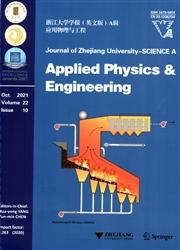Modeling the optimal compensation capacitance of a giant magnetostrictive ultrasonic transducer with a loosely-coupled contactless power transfer system
IF 3.9
3区 工程技术
Q1 ENGINEERING, MULTIDISCIPLINARY
引用次数: 1
Abstract
The giant magnetostrictive rotary ultrasonic processing system (GMUPS) with a loosely-coupled contactless power transfer (LCCPT) has emerged as a high-performance technique for the processing of hard and brittle materials, owing to its high power density. A capacitive compensation is required to achieve the highest energy efficiency of GMUPS to provide sufficient vibration amplitude when it works in the resonance state. In this study, an accurate model of the optimal compensation capacitance is derived from a new electromechanical equivalent circuit model of the GMUPS with LCCPT, which consists of an equivalent mechanical circuit and an electrical circuit. The phase lag angle between the mechanical and electrical circuits is established, taking into account the non-negligible loss in energy conversion of giant magnetostrictive material at ultrasonic frequency. The change of system impedance characteristics and the effectiveness of the system compensation method under load are analyzed. Both idle vibration experiments and machining tests are conducted to verify the developed model. The results show that the GMUPS with optimal compensation capacitance can achieve the maximum idle vibration amplitude and smallest cutting force. In addition, the effects of magnetic conductive material and driving voltages on the phase lag angle are also evaluated.建立了具有松散耦合非接触式功率传输系统的超磁致伸缩超声换能器的最优补偿电容模型
超磁致伸缩旋转超声加工系统(GMUPS)具有松散耦合非接触式功率传输(LCCPT),由于其高功率密度,已成为加工硬脆材料的一种高性能技术。为了使GMUPS在谐振状态下工作时能够提供足够的振动幅度,需要电容性补偿来实现最高的能量效率。本文从LCCPT GMUPS的机电等效电路模型出发,推导出最优补偿电容的精确模型,该模型由等效机械电路和等效电路组成。考虑超磁致伸缩材料在超声频率下能量转换时不可忽略的损耗,建立了机械电路和电路之间的相位滞后角。分析了负载作用下系统阻抗特性的变化和系统补偿方法的有效性。通过怠速振动试验和加工试验验证了模型的正确性。结果表明,补偿电容最优的GMUPS能实现最大的怠速振动幅值和最小的切削力。此外,还分析了导电材料和驱动电压对相位滞后角的影响。
本文章由计算机程序翻译,如有差异,请以英文原文为准。
求助全文
约1分钟内获得全文
求助全文
来源期刊

Journal of Zhejiang University-SCIENCE A
工程技术-工程:综合
CiteScore
5.60
自引率
12.50%
发文量
2964
审稿时长
2.9 months
期刊介绍:
Journal of Zhejiang University SCIENCE A covers research in Applied Physics, Mechanical and Civil Engineering, Environmental Science and Energy, Materials Science and Chemical Engineering, etc.
 求助内容:
求助内容: 应助结果提醒方式:
应助结果提醒方式:


